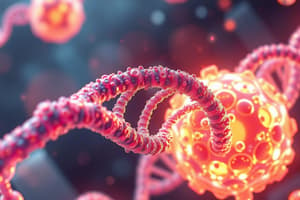Podcast
Questions and Answers
What is the primary purpose of recombinant DNA technology?
What is the primary purpose of recombinant DNA technology?
- To decrease the rate of mutation in DNA
- To enhance the efficiency of cellular respiration
- To locate, isolate, alter, and study DNA segments (correct)
- To create a complete genome from scratch
How do restriction enzymes protect bacterial DNA from being cut?
How do restriction enzymes protect bacterial DNA from being cut?
- By cutting their own DNA at random intervals
- By removing DNA segments that resemble the recognition sequence
- By only activating when a virus is present
- By adding methyl groups to their own recognition sequences (correct)
What characteristic is common among most recognition sequences for restriction enzymes?
What characteristic is common among most recognition sequences for restriction enzymes?
- They are longer than 8 base pairs
- They contain multiple rare nucleotides
- They are palindromic sequences (correct)
- They are circular in structure
What results from the action of restriction enzymes on DNA?
What results from the action of restriction enzymes on DNA?
Which limitation is associated with the use of restriction enzymes?
Which limitation is associated with the use of restriction enzymes?
Which technique is associated with genome editing?
Which technique is associated with genome editing?
What is one of the roles of engineered nucleases in molecular genetics?
What is one of the roles of engineered nucleases in molecular genetics?
Why are restriction enzymes important in genetic engineering?
Why are restriction enzymes important in genetic engineering?
In what way can DNA fragments be analyzed after being cut by restriction enzymes?
In what way can DNA fragments be analyzed after being cut by restriction enzymes?
What does PCR stand for and its primary use in molecular genetics?
What does PCR stand for and its primary use in molecular genetics?
Flashcards
Recombinant DNA Technology
Recombinant DNA Technology
A set of molecular techniques used to locate, isolate, alter, and study DNA segments, often combining DNA from different sources.
Restriction Enzymes
Restriction Enzymes
Naturally occurring enzymes produced by bacteria used to cut DNA at specific sequences.
Recognition Sequence
Recognition Sequence
A specific DNA sequence recognized and cut by a restriction enzyme.
Palindromic Sequence
Palindromic Sequence
A DNA sequence that reads the same backward as forward on both complementary strands.
Signup and view all the flashcards
Cohesive (Sticky) Ends
Cohesive (Sticky) Ends
The ends of a DNA molecule produced by restriction enzymes with overhangs of unpaired bases.
Signup and view all the flashcards
Targeted Mutagenesis
Targeted Mutagenesis
Molecular techniques for analyzing gene function altering genes to study their role.
Signup and view all the flashcards
PCR (Polymerase Chain Reaction)
PCR (Polymerase Chain Reaction)
A technique used to amplify a specific DNA fragment.
Signup and view all the flashcards
DNA Sequencing
DNA Sequencing
Determining the precise order of nucleotides in a DNA fragment.
Signup and view all the flashcards
Genome Editing with CRISPR-Cas
Genome Editing with CRISPR-Cas
Advanced method for precise DNA modification.
Signup and view all the flashcards
Visualizing DNA Fragments
Visualizing DNA Fragments
Using techniques like gel electrophoresis to see and separate DNA fragments.
Signup and view all the flashcardsStudy Notes
Molecular Genetic to Understand Species Biology
- This study focuses on molecular techniques for understanding species biology.
- The outline includes understanding techniques for cutting and visualizing DNA molecules.
- Discusses copying DNA fragments using PCR.
- Explains how DNA fragment base sequences are determined.
- Describes molecular techniques for analyzing gene function, including targeted mutagenesis.
- Details how molecular genetics is applied in practical applications.
Recombinant DNA Technology
- Recombinant DNA technology is a set of techniques for locating, isolating, altering, and studying DNA segments from different sources.
- It's frequently used to combine DNA from two distinct sources—often genes from bacteria to human genes inserted in viral chromosomes.
- Also referred to as genetic engineering.
Restriction Enzymes
- Produced naturally by bacteria for defense against viruses.
- Bacteria protect their own DNA by modifying recognition sequences, often through methylation.
- Approximately 800 different restriction enzymes exist that recognize over 100 different DNA sequences.
Engineered Nucleases
- Developed to overcome the limitations of restriction enzymes.
- Their recognition sequences are longer and more specific.
- These allow for more precise cutting of DNA at specific locations.
- Examples include Zinc-Finger Nucleases (ZFNs) and Transcription Activator-Like Effector Nucleases (TALENs).
CRISPR-Cas System
- A naturally occurring system in bacteria and archaea used for defense against viruses.
- Consists of CRISPR RNAs (crRNAs) that are encoded by DNA sequences—Clustered Regularly Interspaced Short Palindromic Repeats (CRISPR).
- This is used for precise editing of DNA sequences.
Separating and Viewing DNA Fragments
- Gel electrophoresis is a technique used to separate DNA molecules based on size and electrical charge.
- Smaller fragments move further in the gel than larger fragments.
- Dyes are used to visualize the separated DNA fragments as bands.
Locating DNA fragments with Probes
- In various molecular techniques, probes (DNA or RNA) with complementary sequences are used to identify specific DNA or RNA sequences.
- Examples including Southern and Northern blotting differentiate based on the target molecule (DNA or RNA). Western blotting is used for proteins.
PCR (Polymerase Chain Reaction)
- A technique used to amplify specific DNA fragments.
- Involves heating DNA to separate strands, cooling for primer annealing, and heating again for DNA polymerase to synthesize new DNA strands.
- Cycle is repeated to amplify the target DNA exponentially.
- Key improvements include the discovery of heat-stable DNA polymerase (Taq polymerase) and automated thermal cyclers.
DNA Sequencing
- Powerful molecular method used for analyzing DNA sequences.
- Di-deoxy sequencing was the original technique for determining DNA sequences.
- Next-generation sequencing methods are faster and less expensive alternatives, allowing for simultaneous sequencing of many DNA fragments.
DNA Fingerprinting
- Uses short tandem repeats (STRs) to identify individuals based on variations in the number of repeats of these sequences within their genome.
- PCR is a common method used in analyzing these sequences.
Analyzing Gene Function
- These techniques include forward and reverse genetics, creating random mutations, targeted mutagenesis, using transgenic animals, knockout mice, and silencing genes using RNA interference (RNAi).
Forward and Reverse Genetics
- Forward: Starts with a phenotype (observable trait) and works to identify the gene responsible.
- Reverse: Starts with a gene sequence and investigates its function by manipulating or inhibiting the gene.
Creating Random Mutations
- Use of mutagens (radiation/chemicals) increases the rate of mutation to facilitate gene function studies.
Targeted Mutagenesis
- Methods for deliberately creating mutations at specific sites within a gene.
- CRISPR-Cas9, site-directed mutagenesis, and oligonucleotide-directed mutagenesis are available techniques for this purpose.
Transgenic Animals
- Organisms that have been genetically modified by adding a foreign DNA sequence (transgene).
- Observing the effects on the phenotype provides insights into the function of the introduced sequence.
Knockout Mice
- Used to study gene function; involves disabling a specific gene to observe changes in the phenotype or observable traits.
Silencing Genes with RNAi
- The RNA interference (RNAi) process that modulates gene expression by silencing or inhibiting the activity of a target gene.
- siRNA molecules match the complementary sequence and the RNA-induced silencing complexes bind to the mRNA, inhibiting transcription or translation.
Biotechnology Applications
- Molecular genetic techniques are used in various fields like pharmaceuticals, specialized bacteria production, agriculture, and genetic testing, as well as gene therapy.
Studying That Suits You
Use AI to generate personalized quizzes and flashcards to suit your learning preferences.




